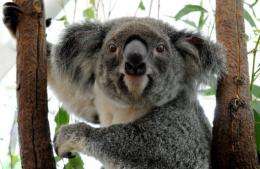Fears for koalas as study reveals 'marked decline'

Australia's much-loved koala is under increasing threat and should be considered a vulnerable species, an official report found Thursday, with habitat loss seeing their numbers plunge.
The furry native marsupial has experienced a "marked decline" as the species faced down threats on a range of fronts including dog attacks and car accidents, according to a government inquiry into koala protection.
Thought to number in excess of 10 million before British settlers arrived in 1788, there are now believed to be as few as 43,515 left in the wild, though their existence high in the treetops makes them difficult to count
Drought, land-clearing, urban development, wildfires and disease were among other serious dangers to the tree-dwellers.
"The koala is an instantly recognisable symbol of Australia as well as being an integral part of Australian cultural heritage," the inquiry said.
Habitat loss was the single greatest threat facing the koala population, leaving them more susceptible to diseases including chlamydia and the koala retrovirus, and fragmenting breeding populations.
Groups in Australia's north were more endangered than those in the south, where they were so abundant in some areas food was running scarce, and the dangers varied from region to region, meaning there were "no easy solutions".
The report urged the government to consider the koala for classing as a vulnerable species, warning that urgent action was required to keep it from drifting "ever closer to the threatened species list."
"The committee is deeply concerned about the sustainability of Australia's koala population," it said.
Mapping and monitoring populations across Australia and genetic research were also among the inquiry's 19 recommendations, which called for the establishment of protected habitat areas, especially on government land.
Disease studies were also vital, including possible vaccination against chlamydia and retrovirus and the impact of changing leaf chemistry.
Wild dog management in priority areas was key, as was lowering speed limits, fencing off danger zones and, if required, building overpasses or underpasses to protect the native creatures, the report said.
Female koalas typically live for 15 years, males for 12, subsisting on a diet of native eucalyptus leaves.
(c) 2011 AFP

















